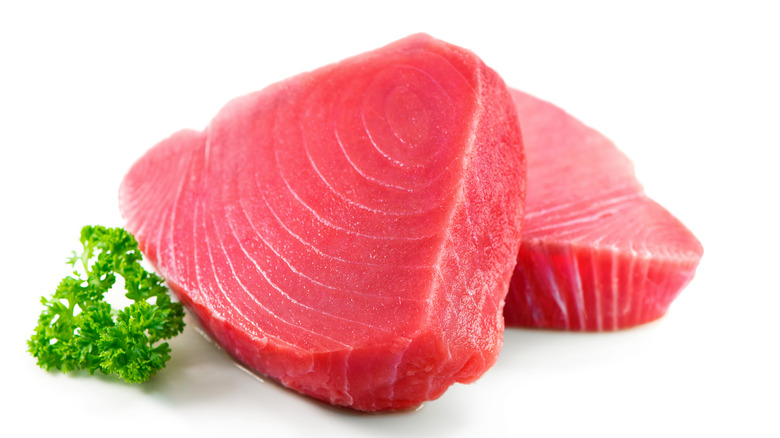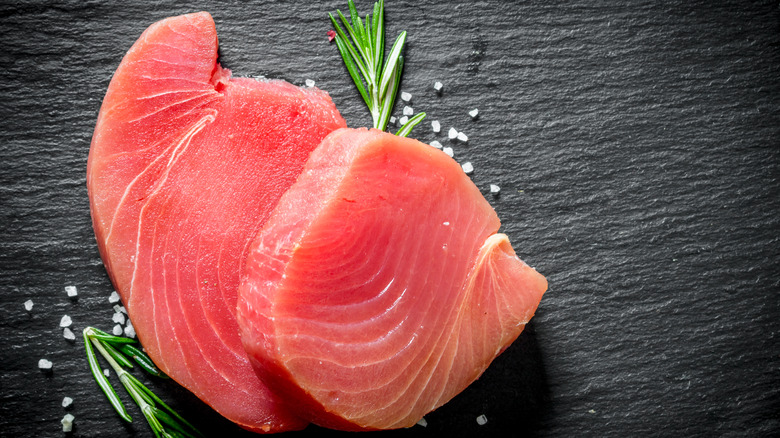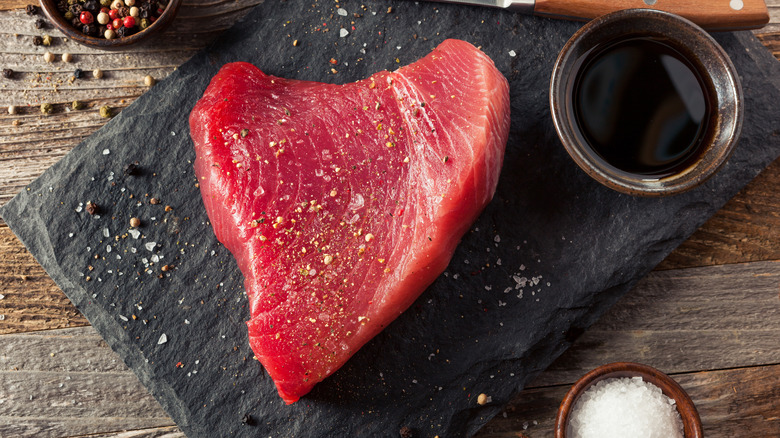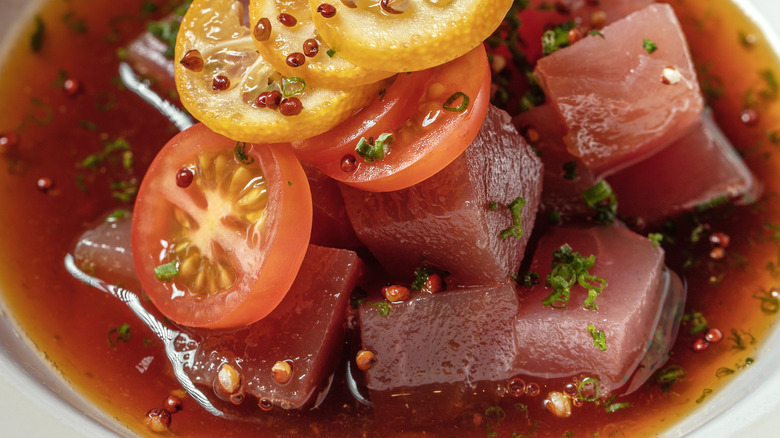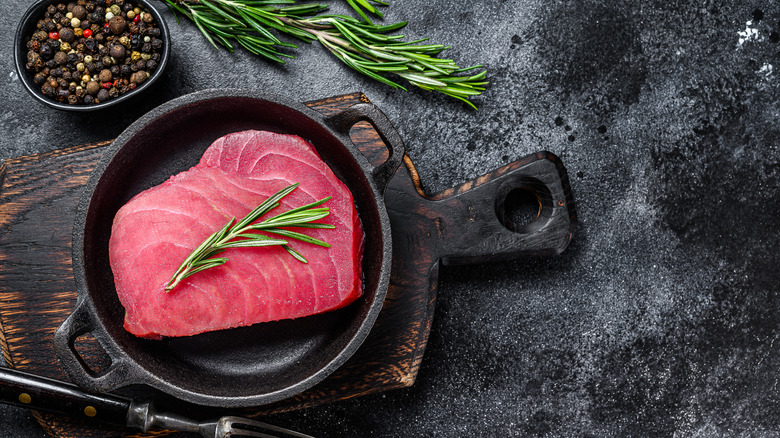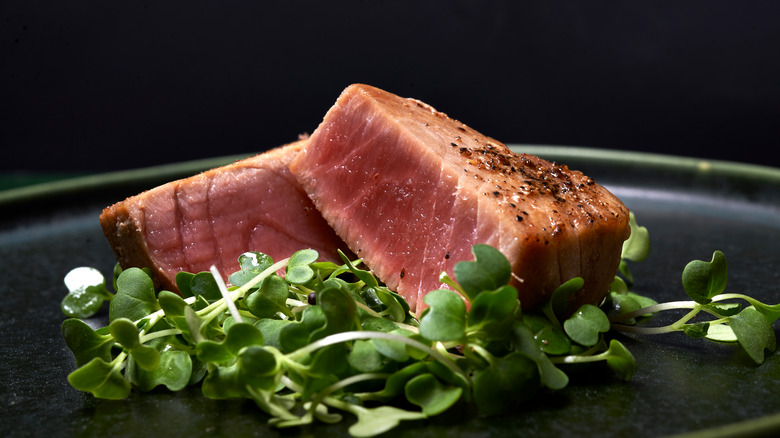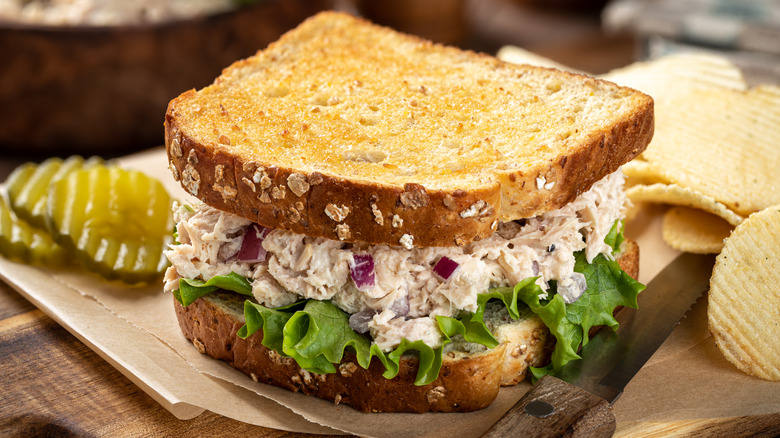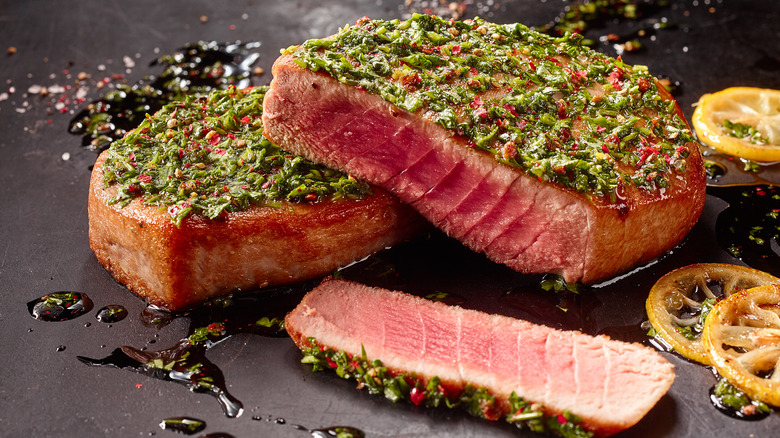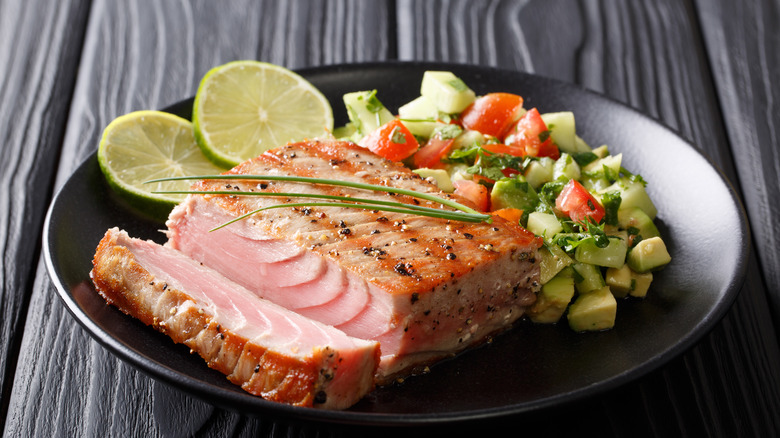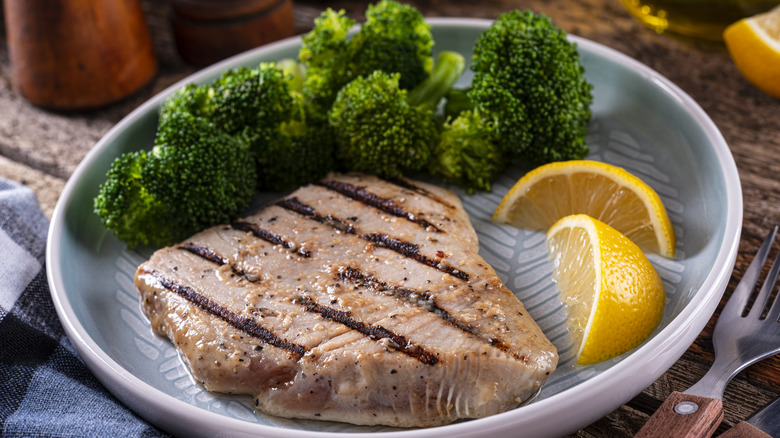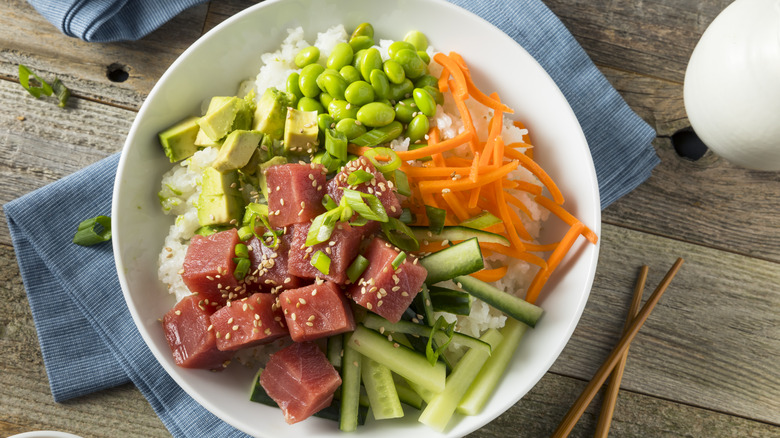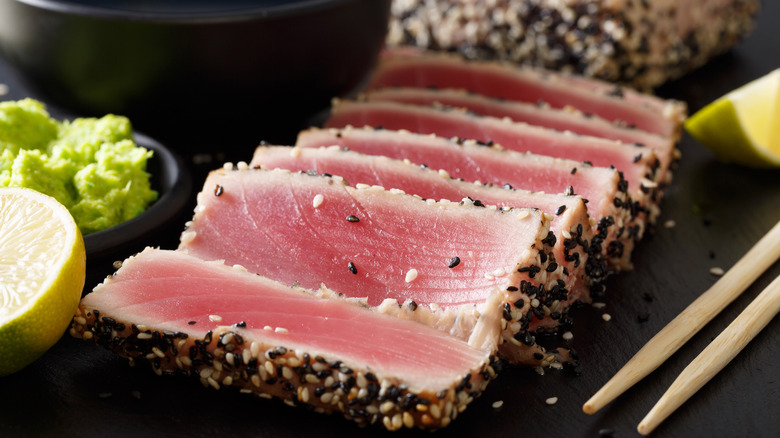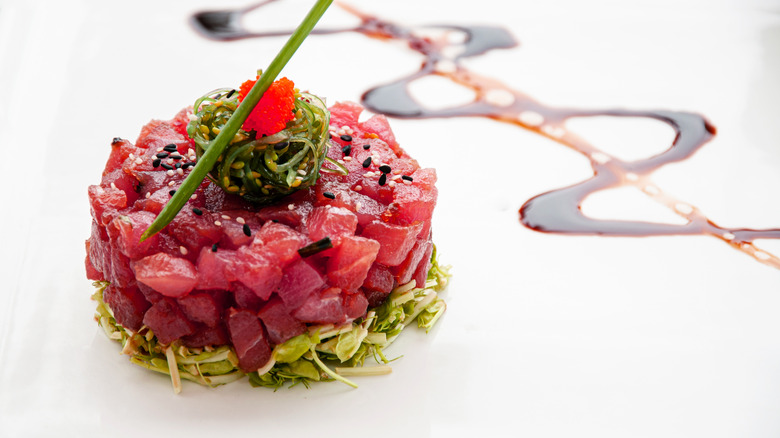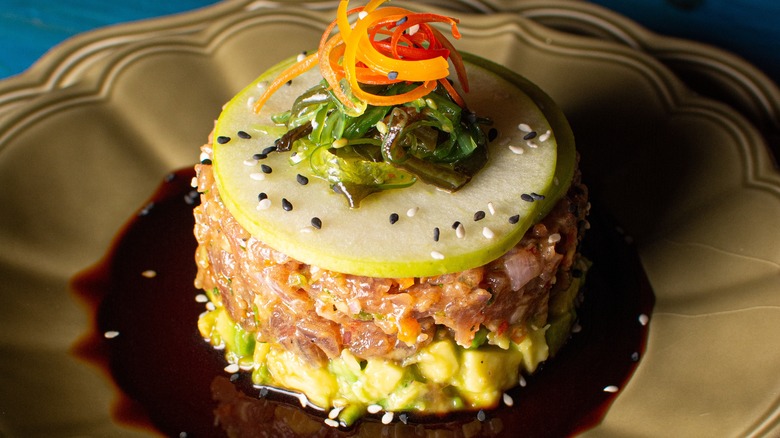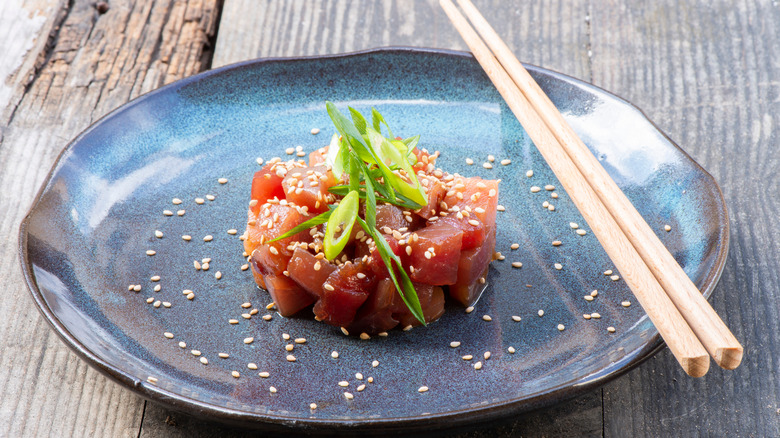14 Tips You Need When Cooking With Tuna
Tuna is a saltwater fish species widely consumed worldwide. According to the U.S. Department of Agriculture, tuna is one of the most nutritious types of fish that is also very abundant in the world's oceans, with a habitat that extends from the Atlantic Ocean to the Indian Ocean. Tuna meat has a characteristic flavor with a delicate sea aroma and a meaty, distinct texture. You can buy it canned, fresh, or raw.
According to WebMD, tuna is an excellent source of vitamin B12, which helps prevent anemia. The fish is also rich in omega-3 fatty acids and is lean meat. In addition, WebMD says tuna is a good source of vitamin D, strengthening the immune system and bone health. However, tuna should be consumed in moderation because, as it is a large fish, it can carry high mercury content. But, for those times you choose to indulge in a flavorful dish, here are some tips for cooking with tuna.
Select the best tuna
Cooking fresh tuna can be daunting, but the flavor, texture, and health benefits of choosing uncooked tuna steaks are well worth the effort. Just imagine a soft tuna steak or a delicious tartare, and you will find that you are willing to replace your canned tuna with a great-looking fresh fillet and have a go at preparing it. However, when selecting fresh tuna filets, there are specific things that you should consider so that you get the best fish available.
First, consider that tuna coloring varies depending on the tuna species. Bluefin and yellowfin tuna are deep red, while albacore tuna has a pale pink color. Despite the possible color variations, you should always avoid tuna that has brown streaks, as these are a clear sign that the fish has been sitting too long and has started to oxidate. Other things to avoid are a slimy aspect and a rainbow sheen that covers the fish fillets. Another significant freshness indicator for tuna is the smell: Avoid the tuna cuts that have an overwhelming fishy smell, which always indicates a lack of freshness.
Prep your tuna
No matter what cooking method you plan on using for your tuna, the way you prep the raw fish is essential in getting the best texture and flavor. Tuna has a special texture, which works excellently in cooked and raw recipes. The right cooking method enhances the flavors of butter and sea, and alongside actual cooking, the preparation process is just as necessary. You don't want to end up with a dry steak on the outside and raw on the inside.
As such, there is one vital aspect to remember when preparing to cook: only use tuna at room temperature. When you cook tuna directly after taking it out of the fridge, it probably won't have enough time to warm through, as searing only takes four minutes to cook a fillet. That's how you sometimes get a dry steak on the outside and cold on the inside. Instead, take your tuna out of the fridge 30 minutes before you start cooking, so it has time to reach an equal temperature. This way, when you put it in a hot pan to sear, you will obtain a consistent texture and taste.
Marinate your tuna
Tuna has tender meat that can quickly soak up different flavors, so marinating it before cooking will give the steak an unmistakable, deeper aroma. In poke bowls or a tuna tartare recipe, tuna is usually first marinated, but marinating is also beneficial for steak preparation.
Marinades usually contain some salty elements to enhance other flavors and spices, depending on your preferences and the food you prepare. Also, tuna marinades include some acid, like lemon and lime juice or flavored vinegar. These are especially helpful when consuming raw tuna, as it will tenderize the fatty notes of the meat. However, if you plan on searing tuna, try adding a sweet component to your marinade. The sweet ingredient will balance out the salt in the marinade, but it will also add a specific delicious flavor to your dish. Moreover, when cooking tuna marinated with the likes of honey, agave nectar, maple syrup, or brown sugar, the sweet component will caramelize over heat and turn to a crust, which will contrast perfectly with the soft and flavorful interior of the fish.
Find the right temperature for cooking tuna
Because tuna has very little fat, it's easy to overcook. On the other hand, you should always ensure that your food is at a safe temperature for consumption when cooking meat. The recommended temperature for fish is above 145 degrees Fahrenheit, according to the Food and Drug Administration. Thus, you have only a very short interval between when the fish is not cooked enough and when it is overcooked.
With tuna steaks, choosing a fresh cut of meat that is also thick enough is essential. Aim for steaks at least an inch thick, and make sure there are no brown spots on the red surface. Before adding the steak, heat the pan to the correct temperature of 425 degrees, then cook the steak for over a minute. Depending on how raw you prefer the interior, you can cook it for a bit more. Keep in mind that letting the interior reach a higher temperature can toughen the tuna. Therefore, removing the steak from the heat is generally advised when the interior reaches 65 degrees.
Choose the ideal cooking method
One of the problems encountered with tuna steak is its tendency to dry out, as it's easy to overcook. Leave it for too long, and you will have a crumbly or chewy steak that has lost the most flavor. However, there are specific methods to ensure you always end up with a perfectly cooked tuna steak.
If you fry tuna, use a dish with a surface that is easy to heat, such as a grill, skillet, or griddle. First, heat the pan, then brush the tuna with oil and seasonings. After that, place the fish in the pan and cook it on each side for one to two minutes. Done! Unlike beef or pork, you don't have to leave tuna to rest before serving. You can also make a tuna confit, which means cooking it in a lot of oil, or using a sous vide technique, which means sealing the meat in a bag and cooking it submerged in water. Sous vide cooking will guarantee that all the moisture remains inside the tuna. Tuna steaks can also be cooked in the oven at a high temperature, resulting in a moist and flavorful dish.
Make tuna salad using fresh tuna
Tuna salad is an all-American favorite, a versatile dish that can be consumed at different times of the day and fulfilling every time. Tuna salad can be upgraded or downgraded any way you like, but it basically means a few ingredients: tuna, mayo, mustard, and relish. Out of these, the most important is, of course, tuna.
If you want to be in complete control of the flavor of your tuna salad, leave out canned tuna and opt for fresh tuna. Canned tuna can often be bland and flaky, but when using fresh tuna, you can cook it any way you like and flavor it according to your preferences. Try making a brine for the tuna to match the other ingredients by using oil, pickle juice, salt, pepper, and celery salt. After you brine the fish, cook it on the grill for 12 minutes, break it into chunks and use it to prepare your favorite tuna salad recipe.
Sear your tuna steak
One of the best ways to serve fresh tuna, especially ahi tuna, is to sear it, leaving the inside rare or medium rare. The dish combines raw tuna's mild, delicate taste and texture with the crispiness and intense flavors. Searing is a technique you learn through practice, with a result that will make you forget about the steep learning curve.
We can provide a few tips that can make you achieve a perfect sear on your ahi tuna steak. If you're not using a marinade, cover the sides of the steak with a combination of dry spices (paprika, thyme, black pepper, garlic powder, and onion powder are good options). When the oil is hot, add the tuna and leave for 45 seconds without moving it, then reduce the heat and cook for another 90 seconds. You'll want to flip the steak before cooking for another three minutes for rare or four minutes for medium rare.
Balance tuna with citrus
The combination of seafood and citrus is usually a flavor fest. The acidity of lemon or lime adds a beautiful counterbalance to the sea flavor and completes any dish nicely. Most tuna recipes will ask you to add a specific acidic element to a marinade, such as citrus fruit or Champagne vinegar.
There are several options available. Lemon or lime juice and zest will add a little zing to your tuna dish, resulting in a great contrasting flavor. You can use citrus for marinades and then cook your tuna steaks, or you can use it raw in tuna tartare recipes. The milder flavor of limes has the advantage of complementing tuna's characteristic taste. Also, try serving your tuna steaks with a slice of lemon or lime to enhance the citrusy flavor and double the acid effect. The lemon will work wonderfully with the buttery taste typical of tuna.
Don't over-marinate tuna steaks
When making a tuna tartare, over-marinating is not usually an issue because the purpose of the acidic marinade is to change the texture of the meat. However, if you want to cook the tuna after marinating it, be sure that you don't leave it for too long, or the meat will become tough when you cook it.
The perfect time for marinating tuna is 15 to 20 minutes to give your steak a deeper flavor. After this time, the acid in the marinade will start cooking the tuna. Citric acid acts like heat on fish molecules, rearranging them. That's why fish in ceviche looks opaque like it has been exposed to heat. When marinating tuna, if you leave the meat in the marinade for too long, it will turn opaque, and if you cook it afterward, you will apply the denaturation process twice. That's why tuna becomes tough when marinated for too long.
Make a poke bowl
A poke bowl is a Hawaiian dish that has grown in popularity over the past years. It uses raw fish and is usually served as an appetizer or a main course. Traditional Hawaiian poke is made with tuna or octopus and doesn't use citrus juice as a curing agent. Instead, the filleted raw fish is usually served with salt and seaweed.
The reinterpreted, modern poke bowl includes a few more elements than the traditional version. For example, you can make a delicious ahi tuna poke bowl recipe that tastes even better than the restaurant version. First, marinate the tuna using soy sauce, sesame oil, and rice vinegar. Leave it for 15 minutes, then assemble your poke using sushi rice, sliced jalapeño, red onion, and cucumber. You can also use other toppings, such as dried seaweed, fish eggs, wasabi, avocado, mushrooms, crispy onions, or pineapple. If you like things spicy, you can also use Sriracha sauce. Restaurants serving poke bowls might also allow you to choose the ingredients for your marinade.
Add a sesame crust to tuna steaks
Sesame-crusted tuna steak is a delicious way to enjoy fresh tuna. The flavors work well when put together, as the rich earthy flavors of sesame complement the complexity of tuna. Sesame-crusted tuna steak can also be served with an arugula salad, steamed rice, roasted lemon potatoes, stuffed peppers, or fried green beans.
A sesame-crusted tuna steak recipe is easy to make, takes a short time, and tastes great. Choose a nice piece of tuna steak. Combine 1 tablespoon of soy sauce with 1 tablespoon of sesame oil, then dip the tuna in the sauce. Dip the tuna in sesame seeds spread on a plate before cooking the tuna steaks. The tuna takes very little time to cook, so leaving it to sear for about one minute will be enough. After you remove the steaks from the pan, slice them into thin slices. You will get a delicious, picture-perfect dish that is just as good as what is served in a restaurant.
Pair tuna with rosé wine
Tuna tartare is synonymous with eloquent taste and is a nutritious food option. This decadent treat is great to have once in a while and is ideal when paired with a rosé wine. According to Slowine, one simple trick is to choose a wine the same color as tuna. Because tuna tartare is pink, a good wine option for this dish is rose wine, which is strong and dry.
This tuna tartare crisps recipe brings out the pink in your tuna and includes a wine-flavored element to complete the flavor. The recipe uses two tart liquids — Champagne vinegar and lime juice — which make up the base for a vinaigrette. Therefore, Wine and Food Matcher says the best recommendations are French rose wines, such as the rich and fruity accents of a Rhone Valley wine like Vacqueyras and Languedoc La Clape or a crisp and dry Provencal Bandol. Also, the unmistakable flavor of basil and lime zest in the vinaigrette matches the fruit flavors of the wine.
Liven up tuna with green apple
If raw tuna is something you're unsure of, an excellent solution to counterbalance the fish's flavor and fattiness is to pair it with crisp green apples in a tuna tartare. Granny Smith apples are ideal for this, as they have a fresh, tangy taste and a crispy texture. To add creaminess and a buttery flavor, serve your tuna tartare with diced avocados. Furthermore, play with some more textures and serve the tartare with rice crisps or pita chips.
Chef Scott Serpas crafted a tuna apple tartare recipe is visually appealing, and the chef serves it in a Melba jar alongside house-made potato chips. To make the recipe, dice 6 ounces of sushi-grade yellowfin tuna and combine it with chopped red onion, Granny Smith apples, and diced avocado. Stir the ingredients gently to combine, then add a marinade with Sriracha sauce, rice vinegar, sesame seeds, granulated sugar, salt, fresh lemon juice, and a mix of raw and toasted sesame seeds. Serve the tuna tartar with kettle chips.
Make tuna tartare decadent with truffle oil
The beauty of a dish like a tuna tartare lies in tuna's capacity to borrow almost any flavor from the ingredients used for the vinaigrette. It can also pair wonderfully contrasting with all kinds of ingredients. For example, you can make a crunchy, salty tuna tartare by incorporating potato chips in the body of your dish. However, you can also keep the crunchy texture and add rich, decadent flavors like anchovy oil or black truffle oil.
You can also make a tuna tartare recipe with watermelon radishes to balance the sharp flavor of fresh horseradish. To prepare the tuna tartare: mix cucumbers, radishes, chives, and diced, raw yellowfin tuna. Then add lemon juice and zest, drizzle with olive oil, and give it another stir. When serving, top the tuna tartare with potato chips, chives, and grated horseradish.
For a truly decadent taste, dice the fish and cover it in soy sauce, shallots, sunflower oil, olive oil, truffle oil, and anchovy oil. Stir in one cup of potato chips and egg yolk, mix, and then serve with a dollop of crème fraiche.
